Welcome to our free classical music site

Do you write about classical music? Are you a blogger? Want to team up with Classical Connect? Send us a message, let's talk!

Do you write about classical music? Are you a blogger? Want to team up with Classical Connect? Send us a message, let's talk!
December 21, 2015. Giovanni Gabrieli. Several times a year we celebrate composers whose birth dates (and sometimes birth years) remain unknown to us. Giovanni Gabrieli is one of them and it seems quite appropriate to celebrate him this time of the year, as we approach Christmas: Gabrieli was mostly a composer of sacred music. Giovanni was a born in Venice, sometime between 1554 and 1557. His family came from the Alpine area of Carnia, north of Venice. Giovanni was probably brought up by his uncle, Andrea Gabrieli, who was probably his first music teacher. And as his uncle did some years earlier, the young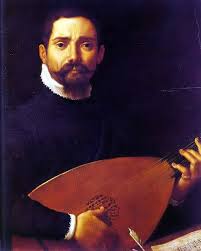 Giovanni traveled to Munich, to the court of the Duke Albert V of Bavaria, to study with the great Orlando di Lasso. He returned to Venice in 1584, and a year later became the organist at the Basilica of San Marco; for several months he shared these responsibilities with Andrea, until Andrea’s death on August 30th of that year. That same year he received another prestigious post, as organist to the Scuola Grande di S Rocco, one of the most important confraternities in Venice. Tintoretto was still working on his famous canvases, decorating the building when Gabrieli assumed his post.
Giovanni traveled to Munich, to the court of the Duke Albert V of Bavaria, to study with the great Orlando di Lasso. He returned to Venice in 1584, and a year later became the organist at the Basilica of San Marco; for several months he shared these responsibilities with Andrea, until Andrea’s death on August 30th of that year. That same year he received another prestigious post, as organist to the Scuola Grande di S Rocco, one of the most important confraternities in Venice. Tintoretto was still working on his famous canvases, decorating the building when Gabrieli assumed his post.
Upon Andrea’s death, Giovanni edited and published a volume of his work; to this volume he also added some of his own compositions. Giovanni’s first major collection of original music, called Sacrae symphoniae, was only published in 1597. Some, if not most, of the pieces in the collection represent music composed for the Scuola. The publication was clearly very successful, as just one year later, in 1598, it was reprinted in Nuremberg. Here’s Sonata Pian'e Forte from the collection, performed by the brass section of the Bavarian State Opera, Zubin Mehta conducting. As Giovanni’s music became famous, pupils started coming from Italy and Europe, many of them sent from Germany. Among them was Heinrich Schütz, who came in 1609 and stayed till Gabrieli’s death. Through Schütz, and other Germans, we can connect Gabrieli with the German baroque tradition and Johann Sebastian Bach.
Gabrieli, like his uncle Andrea and Adrian Willaert before him, wrote much music in the Venetian “polychoral” style. This style has an unusual history: unlike practically anything else in music, its existence was a direct result of the architectural peculiarities of the main cathedral of Venice, the San Marco. San Marco’s shape differs from all other large Italian churches. Instead of having a long, wide nave, it’s built as an equal-armed cross, having the length and the width of about the same size. Additional smaller chapels in both the nave and the transept further complicate the structure. As there is not enough space for one large choir, there are two, on the opposite sides of the church. As a result, the sound echoes throughout the building with the delays forming very unusual effects. Gabrieli wrote a large number of choral and brass pieces that took advantage of these effects. Here’s a great example, Canzon à 12 in Echo. It’s performed by the brass sections of three great orchestras, the Philadelphia, the Cleveland, and the Chicago.
PermalinkDecember 14, 2015. Beethoven! This week we celebrate Ludwig van Beethoven’s 245th birthday. Beethoven was baptized on December 17th of 1770, so it’s often assumed that he was born the previous day, on December 16th. We usually celebrate his birthday by focusing on different periods of his life during which he wrote some of his piano sonatas: last year, for example, we finished with the Piano sonata no. 4, which was published in 1797. This time we’ll change tracks a bit and present a longer article on his two symphonies, no 3, the famous Eroica, and no. 4. We’ll continue the traversal of Beethoven’s piano sonatas later on. You can hear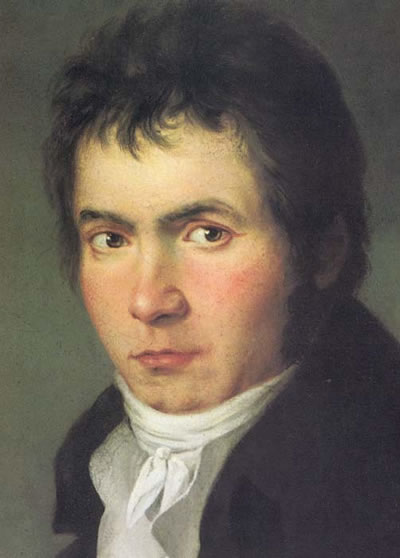 Eroica in the performance by the Berlin Philharmonic under the direction of Herbert von Karajan in the 1984 recording here, and Symphony no. 4, in the live recording made by Carlos Kleiber with the Bavarian State Orchestra in 1982, here. ♫
Eroica in the performance by the Berlin Philharmonic under the direction of Herbert von Karajan in the 1984 recording here, and Symphony no. 4, in the live recording made by Carlos Kleiber with the Bavarian State Orchestra in 1982, here. ♫
Symphony No. 3. With the closing measures of the Symphony No. 2 in D major, Beethoven embarked down the “new road” he announced in a letter to Krumpholz in 1802: “I am not satisfied with my works up to the present time. From today I mean to take a new road.” While this turning point—this new artistic direction—can be seen in the Violin Sonatas, op. 30 or the Piano Sonatas, op. 31, it is most striking apparent in the comparison of the Second Symphony to its successor, the Eroica. Premonitions of Beethoven’s mature style surfaced at times in the first two symphonies—most noticeably in the Minuet of the First and the Finale of the Second. However, the Third Symphony is pure Beethoven as he is so beloved today.
Beethoven began working on the Symphony No. 3 in E-flat shortly after the Second and was occupied with it until early 1804, with much of the actual composition beginning during the summer of 1803. By the spring of 1804, a fair copy of the score had been made, which was openly displayed on Beethoven’s desk. On the outside page written at the very top was the name “Buonaparte,” and at the bottom, “Luigi van Beethoven.” The first suggestion of a symphony in honor of Napoleon Buonaparte had likely been made to Beethoven as early as 1798. At this time, Napoleon was known as a great statesman and a champion of freedom, and had not yet transformed, in his fall from glory, into the tyrant that waged war across Europe. The French Revolution had certainly influenced Beethoven, quite possibly through Bonn’s proximity to France. Indeed, his very character embodied its ideals. Once in Vienna, he was a contradiction to all the expectations of musicians of that day. Besides refusing to enter the service of any of the nobility, he asserted his independence with manners that were off-putting even to his friends and a lack of etiquette or respect towards his professed superiors. He took what was his by right and refused to see them as favors. This freedom of spirit is certainly evident in the earlier symphonies but the Third is its undeniable embodiment. Napoleon had become the quintessence of the French Revolution’s ideals, and it is quite nature that Beethoven should admire him.
However, Beethoven had no knowledge of the changes taking place in Napoleon. On May 2, 1804, the Senate passed a motion asking Napoleon to take the title of Emperor. Later that month, on the 18th, he assumed the title. When the news finally reached Vienna, Ferdinand Ries delivered it to Beethoven. “After all, then, he is nothing but an ordinary mortal! He will trample all the rights of men under foot, to indulge his ambition, and become a greater tyrant than any one,” was the reply that erupted from the composer. In his fury, Beethoven grabbed the score of his new symphony, tore the title page, and threw it on the ground. For seventeen years, Beethoven never mentioned the connection between the work and Napoleon until, on hearing news of Emperor’s death, he replied, “I have already composed the proper music for that catastrophe”—an obvious reference to the Funeral March which forms the symphony’s second movement. On the copy of Beethoven’s score preserved today, one can visibly see the hatred with which Beethoven scratched out Napoleon’s name from the title page. (Continue reading here).Permalink
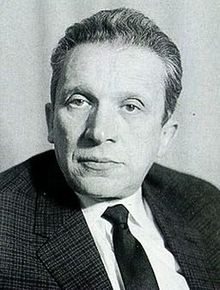 Weinberg was born in 1919 in Warsaw and fled to the Soviet Union at the outbreak of t WWII when the Germans attacked Poland (his parents and sister perished during the Holocaust). Weinberg wrote twenty-two symphonies and more than 20 quartets, but his music was practically ignored in the Soviet Union, even though many considered him the third most important composer in the country after Prokofiev and Shostakovich. That changed somewhat with the revival of his opera “The Passenger.” The opera tells a story of a German couple on a cruise. The woman seems to recognize a fellow passenger and in a moment of shock, reveals to her husband that she worked as a guard in a concentration camp where the other passenger was an inmate. The harrowing story of the life in the camp is recounted on a lower deck of the ship. A Polish play by Zofia Posmysz, herself a concentration camp survivor, which served as the basis for the opera libretto, was also used by the talented Polish director Andrzej Munk for the screenplay of his 1963 film, “Passenger.” Weinberg’s opera was scheduled for a premiere in 1968 in the Bolshoi Theater but was canceled by the Soviet authorities at the last moment. The first concert performance took place in 2006 in Moscow; the opera was then properly staged in Europe in 2010 and in the US in 2014 (it had its very successful Chicago premier at the Lyric Opera earlier this year). Here’s Weinberg’s instrumental piece, his piano sonata no. 3, op. 31. It’s performed by Murray McLachlan.
Weinberg was born in 1919 in Warsaw and fled to the Soviet Union at the outbreak of t WWII when the Germans attacked Poland (his parents and sister perished during the Holocaust). Weinberg wrote twenty-two symphonies and more than 20 quartets, but his music was practically ignored in the Soviet Union, even though many considered him the third most important composer in the country after Prokofiev and Shostakovich. That changed somewhat with the revival of his opera “The Passenger.” The opera tells a story of a German couple on a cruise. The woman seems to recognize a fellow passenger and in a moment of shock, reveals to her husband that she worked as a guard in a concentration camp where the other passenger was an inmate. The harrowing story of the life in the camp is recounted on a lower deck of the ship. A Polish play by Zofia Posmysz, herself a concentration camp survivor, which served as the basis for the opera libretto, was also used by the talented Polish director Andrzej Munk for the screenplay of his 1963 film, “Passenger.” Weinberg’s opera was scheduled for a premiere in 1968 in the Bolshoi Theater but was canceled by the Soviet authorities at the last moment. The first concert performance took place in 2006 in Moscow; the opera was then properly staged in Europe in 2010 and in the US in 2014 (it had its very successful Chicago premier at the Lyric Opera earlier this year). Here’s Weinberg’s instrumental piece, his piano sonata no. 3, op. 31. It’s performed by Murray McLachlan.
December 7, 2015. This is another unusually bountiful week. Monday the 7th is the birthday of Pietro Mascagni, the composer of Cavalleria Rusticana, one of the two greatest verismo operas. Mascagni was born in 1863 and wrote Cavalleria in 1890. It was premiered earlier than Verdi’s Falstaff, which was staged in 1893. Hard to imagine that Mascagni died in August of 1945: as wonderful as it is, his music belonged to a bygone era. Another Italian, Bernardo Pasquini, one of the most important keyboard composers of the late 17th – early 18th century, was also born on this day, in 1637. Here’s his delightful “Toccata del cucco“ (the Cuckoo toccata), which Ottorino Respighi used practically verbatim in his orchestral suite Gli Uccelli (The Birds). Here, though, it’s played the way Pasquini intended, on a harpsichord. It’s performed by Lorenzo Ghielmi. The following day (the 8th) we have four anniversaries with all four composers coming from the different countries: Jean Sibelius, the great Finnish composer who was born in 1865. Manuel Ponce, probably the best known Mexican composer (Ponce was born in 1882), a very interesting Czech composer Bohuslav Martinu, who was born in 1890, and finally, Mieczyslaw Weinberg, a Soviet composer of Polish-Jewish descent (he was known in the Soviet Union as Moisey Weinberg).
What we had so far is plenty already, but there are more anniversaries this week: the Spanish composer Joaquin Turina was born on the 9th, in 1882; César Franck – on the 10th of December, in 1822. The same day is the birthday of one of our favorite composers, Olivier Messiaen. Another Frenchman of immense talent, Hector Berlioz was born on December 11th of 1803. And finally, on the same day in 1908 Elliott Carter was born in Manhattan. Carter died in 2012, one month short of his 104th birthday. He wrote his last composition three months earlier. Carter is a seminal American composer and we’ll dedicate an entry to him alone sometime later. Right now, though, here’s his String Quartet No.5. It’s a difficult piece but very much worth the effort. It’s performed live by the Pacifica Quartet.Permalink
November 30, 2015. Dieterich Buxtehude. Throughout the Renaissance, what we know as “vital records” were kept mostly by churches, but those were not always well organized: the baptismal date of a child born into nobility would be recorded, but not necessarily that of a poor one. As very few of the composers of the period came from the nobility (Carlo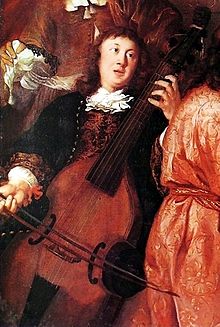 Gesualdo being a notable exception), we don’t know when such giants of early music as Guillaume Dufay, Josquin des Prez, Giovanni Pierluigi da Palestrina or Orlando di Lasso were born. Lapses occurred even much later: Jeremiah Clarke, a famous English baroque composer, was born in 1674, but exactly when we don’t know. The story is even murkier with Dietrich Buxtehude: not only don’t we know when was he born, we’re not even sure in which country. The name Buxtehude seems to suggest that the family came from the town of Buxtehude, not far from Hamburg, but at some point the Buxtehudes moved to Denmark. Most historians believe that Dietrich was born around 1637, maybe in Helsingborg, formerly Danish and now a Swedish town, or in Elsinore on the Danish side of the sound -the town famous for its castle where Shakespeare set his Hamlet. Dietrich’s father was an organist, and most likely his first music teacher. We do know that in 1668 Dietrich Buxtehude settled in Lübeck: the position of organist of Marienkirche, one of the most important in Northern Germany, became vacant, and Buxtehude applied, as did several other organists. Marienkirche, built in 1250, an imposing Gothic structure, had two organs: the great organ originally built in 1516, probably the largest gothic organ in the world, and a smaller “Dance Macabre” organ, located in the transept – it was called “Dance macabre” for a famous painting of the same name that hung in the transept. Unfortunately, both organs, as well as the painting, were destroyed in 1942 during the bombing of the city by the British air force. The bombing created a huge firestorm, which devastated a large part of the historical center; even the famous bells of Marienkirche partially melted down and fell to the floor, breaking into pieces.
Gesualdo being a notable exception), we don’t know when such giants of early music as Guillaume Dufay, Josquin des Prez, Giovanni Pierluigi da Palestrina or Orlando di Lasso were born. Lapses occurred even much later: Jeremiah Clarke, a famous English baroque composer, was born in 1674, but exactly when we don’t know. The story is even murkier with Dietrich Buxtehude: not only don’t we know when was he born, we’re not even sure in which country. The name Buxtehude seems to suggest that the family came from the town of Buxtehude, not far from Hamburg, but at some point the Buxtehudes moved to Denmark. Most historians believe that Dietrich was born around 1637, maybe in Helsingborg, formerly Danish and now a Swedish town, or in Elsinore on the Danish side of the sound -the town famous for its castle where Shakespeare set his Hamlet. Dietrich’s father was an organist, and most likely his first music teacher. We do know that in 1668 Dietrich Buxtehude settled in Lübeck: the position of organist of Marienkirche, one of the most important in Northern Germany, became vacant, and Buxtehude applied, as did several other organists. Marienkirche, built in 1250, an imposing Gothic structure, had two organs: the great organ originally built in 1516, probably the largest gothic organ in the world, and a smaller “Dance Macabre” organ, located in the transept – it was called “Dance macabre” for a famous painting of the same name that hung in the transept. Unfortunately, both organs, as well as the painting, were destroyed in 1942 during the bombing of the city by the British air force. The bombing created a huge firestorm, which devastated a large part of the historical center; even the famous bells of Marienkirche partially melted down and fell to the floor, breaking into pieces.
Buxtehude was selected as the organist on April 11th of 1668 and two months later became a citizen of Lübeck. Buxtehude’s official duties at Marienkirche required him to compose and play music during Sunday services and major holidays. In addition to his religious duties, he directed concerts known as Abendmusic, which took place in the same church. These concerts featured mainly organ music and, after Buxtehude took over, orchestral and choral music. The concerts became very popular among Lübeck’s bourgeois and known even outside the city. Buxtehude composed several oratorios for Abendmusic, most of which were, unfortunately, lost. He lived in Lübeck for the rest of his life, an eminent citizen and “music director” for the city. In 1699, Pachelbel dedicated his Hexachordum Apollinis to Buxtehude. In 1703 the young Handel visited him, and three years later, in 1706, Bach came “in order to learn one thing and another about his art,” according to theArnstadt records. It’s very likely that Bach was present at at least two Abendmusic concerts. Buxtehude died on May 9th of 1707 and was buried in Marienkirche.
Buxtehude composed more than 100 cantatas, but his most important work was written for the organ. Here, for example, is Prelude in G minor. The influence he had on Johann Sebastian Bach seems rather obvious. The organist is Ton Coopman, who, after recording all works of Bach, embarked on the Buxtehude Project, recording the complete works of Bach’s predecessor. The project was successfully finished in 2014. The portrait of Buxtehude, above, is from a painting by the Dutchman Johannes Voorhout. It was made in 1674. Permalink
November 23, 2015. Nine composers of note were born this week, starting with Jean-Baptiste Lully, who was born in Florence on November 28th of 1632, to Krzysztof Penderecki, the Polish composer who, at the ripe age of 81 (he was born on November.jpg) 23rd of 1933) is still actively writing music and conducting. Between these two, in chronological order, we have: Anton Stamitz, a son of Johann Stamitz, the founder of the Mannheim School and the brother of Carl, another prominent composer. Anton was born on November 27th of 1750. He spent the second half of his life in France. Sometime after the French revolution he went mad and lived in an asylum for the rest of his life. It’s not known when he died. From the happier years of his life, here’s the Concerto for two flutes; Shigenori Kudo and Jean-Pierre Rampal are the flutists, Josef Schneider conducts the Salzburg Mozarteum Orchestra. Gaetano Donizetti, one of the greatest composers of the bel canto opera, was born on November 29th of 1797. Another Anton, the Russian composer Anton Rubinstein was born on November 28th of 1829. Rubinstein, one of the supreme piano virtuosos of the 19th century, was the founder of the St-Petersburg Conservatory, the first in Russia. There he taught composition, and among his students was none other than Pyotr Ilyich Tchaikovsky. Another interesting Russian composer, Sergei Taneyev , was born on November 25th of 1856. A generation younger than Anton Rubinstein, Taneyev was a friend of Anton’s brother, Nikolai; he was even closer with Tchaikovsky. Taneyev had impeccable taste and was the only one whom Tchaikovsky openly trusted and allowed to discuss his music. Here’s the Gigue from Taneyev’s Quartet no 6, written in 1905. It’s performed by one of the foremost Russian chamber ensembles, the string quartet named after the composer: The Taneyev Quartet.
23rd of 1933) is still actively writing music and conducting. Between these two, in chronological order, we have: Anton Stamitz, a son of Johann Stamitz, the founder of the Mannheim School and the brother of Carl, another prominent composer. Anton was born on November 27th of 1750. He spent the second half of his life in France. Sometime after the French revolution he went mad and lived in an asylum for the rest of his life. It’s not known when he died. From the happier years of his life, here’s the Concerto for two flutes; Shigenori Kudo and Jean-Pierre Rampal are the flutists, Josef Schneider conducts the Salzburg Mozarteum Orchestra. Gaetano Donizetti, one of the greatest composers of the bel canto opera, was born on November 29th of 1797. Another Anton, the Russian composer Anton Rubinstein was born on November 28th of 1829. Rubinstein, one of the supreme piano virtuosos of the 19th century, was the founder of the St-Petersburg Conservatory, the first in Russia. There he taught composition, and among his students was none other than Pyotr Ilyich Tchaikovsky. Another interesting Russian composer, Sergei Taneyev , was born on November 25th of 1856. A generation younger than Anton Rubinstein, Taneyev was a friend of Anton’s brother, Nikolai; he was even closer with Tchaikovsky. Taneyev had impeccable taste and was the only one whom Tchaikovsky openly trusted and allowed to discuss his music. Here’s the Gigue from Taneyev’s Quartet no 6, written in 1905. It’s performed by one of the foremost Russian chamber ensembles, the string quartet named after the composer: The Taneyev Quartet.
The path-breaking Spanish composer Manuel de Falla was born on November 23rd, 1876 in Cádiz, Spain. He wrote a lot of music for the stage: zarzuelas (traditional Spanish musical comedies), a ballet that became famous, The Three-Cornered Hat, and even a puppet opera. He also wrote some orchestral and piano music. One of his best known piano compositions is Fantasia Betica. It’s performed here by Tanya Gabrielian. The American composer Virgil Thomson was born 20 years later, on November 25th, 1896. A pupil of Nadia Boulanger and a friend of Gertrude Stein, he lived in Paris from 1925 to 1940. These days he’s better known as one of the most influential American music critics but he was a whimsical and interesting composer. His opera “Four Saints in Three Acts” on the libretto by Stein is a revolutionary piece of music.
Alfred Schnittke, who was born on November 24th of 1934 and Krzysztof Penderecki are among the most significant composers of the second half of the 20th century. We’ve written about Schnittke a number of times but haven’t had a chance to discuss Penderecki. A complex and prolific composer who during his long creative life went through a number of phases, from atonal to melodic, Penderecki requires a separate entry. In the meantime, here’s his Threnody for the Victims of Hiroshima. National Polish Radio Symphony Orchestra is conducted by Antoni Wit. Permalink
November 16, 2015. Beethoven's Symphonies nos. 1 and 2. Today we're publishing an essay on Ludwig van Beethoven's two early symphonies. To illustrate, we use the recordings made by the Orchestra of the Eighteenth Century, Frans Brüggen conducting (Symphony no. 1) and London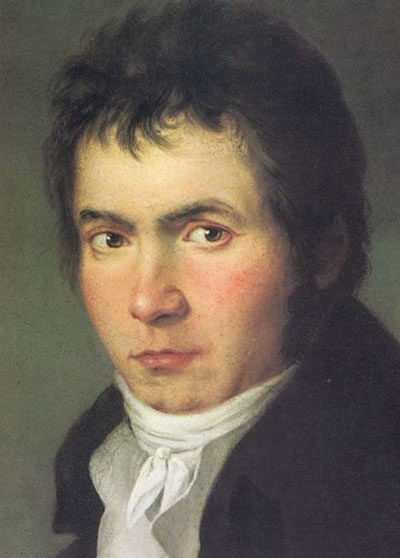 Symphony Orchestra under the baton of Josef Krips (Symphony no. 2). ♫
Symphony Orchestra under the baton of Josef Krips (Symphony no. 2). ♫
Beethoven and the symphony are nearly synonymous. It is impossible to speak of one without discussing the other. In short, the symphony was one of the genres of instrumental composition that was radically transformed at the mighty hands of Beethoven. Everything before him seems but a prelude; everything after, as Richard Wagner commented, an “epilogue.”
The symphony, as a musical composition, traces its roots to the waning years of the Renaissance. The term itself is far older—originating from the Greek “symphonia,” meaning “agreement or concord of sound.” The earliest pieces that bore the title of “symphony” were works by composers such as Giovanni Gabrieli, Andriano Banchieri, and Heinrich Schütz. These works were all sacred vocal compositions with or without instrumental accompaniment. As the Baroque period reached its maturity, the “symphony” or “sinfonia” was applied to a wide range of instrumental compositions from operatic overtures to keyboard pieces (Bach’s three-part inventions were called “Sinfonias”). By the 18th century, the Italian overture had developed into a well-defined form of three contrasting movements—fast, slow, fast—and is generally considered to be the immediate progenitor of the modern symphony.
As the Baroque period faded, the symphony became one of the hallmarks of the burgeoning Classical period. Pioneered by composers such as Sammartini, Wagenseil, von Dittersdorf, and Stamitz, it reached the brink of maturity in the works of Haydn and Mozart. Slowly, the four-movement form common since the 19th century replaced the inherited three-part design of the Baroque. Symphonies became an increasingly prominent fixture of public life and were thus written at a profuse rate (Haydn composed 107, and Mozart at least 47), fueled in large part by the musical establishments maintained by the aristocracy and the competition that resulted amongst them.
With Beethoven the fullest potential of the symphony was realized. Not writing for any court, Beethoven was free to develop the symphony into a vehicle for his artistic will. With the exception of Haydn and Mozart, the symphony had generally been the product of artisans throughout the Classical period. Beethoven made it the domain of artists—a blank canvas for the composer to envision the highest potential of his art. He adopted the symphonic design of his predecessors but vastly expanded the breadth and scope of each individual movement. His most well-known contribution is, of course, the transformation of the old Classical Minuet into the Scherzo, which became the dance movement of choice in virtually every multi-movement design throughout the Romantic period. The outer movements became more profound, not to mention larger, with every aspect developing out of their basic motives. In accordance with this change, coda sections also were greatly expanded, and became in essence added "developments" in which musical ideas were further explored. Lastly, within his slow movements, Beethoven plunged the depths of the human soul and soared into the heights of heaven.
Beethoven's radical transformations touched virtually every symphonist for the next century. Schubert quickly followed in his idol's footsteps, culminating his symphonic output with the severe pathos of his Unfinished Symphony and the colossal grandeur of his "Great" C major Symphony. Berlioz developed further on the programmatic elements of Beethoven's Pastoral Symphony, creating dramatic and ground-breaking works such as the Symphonie fantastique and the Roméo et Juliette Symphony. Following Schubert's death, the banner of German symphonism was carried by Mendelssohn and Schumann, and ultimately passed to Johannes Brahms. Brahms introduced his own innovations, supplanting the Scherzo with his characteristic Intermezzi in three of his four symphonies, while introducing the archaic passacaglia as an effective Finale in his Fourth. Yet, one can certainly find within them the hand Beethoven, particularly in his First Symphony. Anton Bruckner, forced to work in Brahms's shadow, created gargantuan symphonies that are certainly influenced by both Beethoven and Wagner. Mahler was a natural successor. His enormous symphonies stretch the form even further and one cannot miss his imitations of Beethoven's immortal Choral Symphony (continue here).Permalink